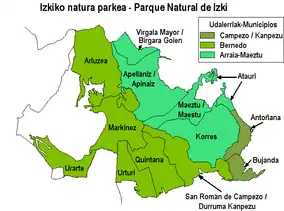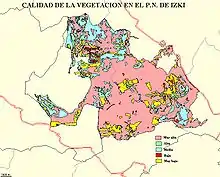Izki Natural Park
Izki Natural Park is located in the eastern quarter of the Province of Álava, in the Basque Country autonomous community, Spain. Its height is between 700 and 800 metres (2,300 and 2,600 ft).
| Izki Natural Park | |
|---|---|
 | |
 Administrative limits of the Izki Natural Park | |
| Location | Álava province, Spain |
| Coordinates | 42.706°N 2.494°W |
| tourism | |
This is a wide zone with a sandy low relief, edged by limestone-based mountains and has its highest point in Kapildui (1,117 m (3,665 ft)). The valley is crossed by the Izki River that receives affluences from various streams. Deep in the valley and near the coomb with the valley's same name is located Corres, the unique village inside the park.
Limits

It limits in the north with the Vitoria's Mountains, in the east with the Berron River, in the south with the Cantabrian Mountain Range, and in the west with Trebiño's county.
Climatology
Izki Natural Park is located in a transition area between the Atlantic and the Mediterranean climate domains. The main winds coming from the northwest find many geographic barriers that prevent the valley from having great rains but allow a rain rate of 600–800 mm (24–31 in) annually. The climate is considered to be semi-wet and has a month-long summer drought. The average temperature is of 11 °C (52 °F).
Fauna
The park's climate, varied vegetation and isolation allow a rich wildlife based on various raptorial birds such as hawks, booted eagles, short toed snake eagles, Egyptian vultures and a few more. But the true ornithological treasure is the middle peak woodpecker that has its largest population of Spain in this park. There are also river mammals like the otter, the Pyrenean desman, the European mink and the more common forest mammals such as the fox, the wildcat and the beech marten. Among amphibians, the Spanish painted frog, the agile frog and the alpine newt inhabit the park.
Flora

Even if the intense and ancient exploitation of the valley's resources has weakened the forest, Europe's largest Quercus pyrenaica woods, with an area of 3,500 hectares (8,600 acres) or 47.94% of the forest, are found in the park. The forest is built over the silicon substrate based and well-drained sandy substrates in the plains of the valley originated by the Berron and the Izki Rivers. The half-Mediterranean half-Atlantic climate in conjunction with the hard insolation and the atmospheric dryness give these species an ecological edge over beech trees.

There are wide areas of beech forest in the higher zones that take an 2.003-hectare (4.95-acre) area representing 27,45% of the park's forests. It stands on neutral or moderately acidic soils rich in carbonates. There are also some spots of acidophile beeches interspersed in the valley.
Portuguese oaks can be found near the humid sectors around the rivers and acquire their maximum splendor in the limestone areas between the villages of Korres and Bujanda and also around Arlucea. As they are young trees their conservation is precarious. These trees are typical in subhumid climates with a 600–900 mm (24–35 in) per year precipitation and short summer droughts. As they need to stand in a fresh ground with a good liquid retention capacity, they usually occupy clayey and marly grounds. Under 650 m (2,130 ft) the Portuguese oak is substituted by the Mediterranean oaks. Groups of downy oaks, field maples and European hollys can also be found. The oaks are the wood's 15.35% occupying an area of 1.12 hectares (2.8 acres).
It is important to mention the existence of silver birch, English oak and holm oak populations in the valley that while there are not many they are important for remarking the ecologic and landscape interests the park has.
Mountain and trekking
Due to the natural diversity and the slopes the terrain has the park offers many trekking paths for appreciation of the landscapes.
- The ascension from San Roman to the Muela mountain. - The ascension from Antoñana to Soila through a forest allows viewing most of the mentioned tree varieties and a couple of especially wide and old lime-trees and yew-trees. - The cliffs in Korres and Bujanda. - The ascension from Marquinez to the Belabia mountain and the visit to the artificial caves. - The tour from Apellaniz to Arlucea passing through the San Justi and the San Cristóbal mountains. - The ascension of the Azaceta mountain pass to Kapildui.